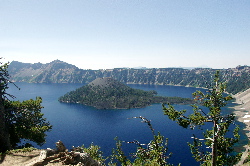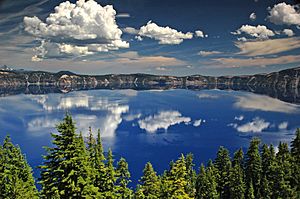Franklin B. Sprague facts for kids
Quick facts for kids
Franklin B. Sprague
|
|
|---|---|
| Born | July 16, 1825 Delaware, Ohio |
| Died | February 7, 1895 (aged 69) Delaware, Ohio |
| Place of burial |
Oak Grove Cemetery Delaware, Ohio
|
| Allegiance | Union |
| Service/ |
|
| Years of service | 1864 - 1867 |
| Rank | |
| Unit | |
| Commands held | I Company; Fort Klamath |
| Battles/wars | American Civil War Indian skirmishes |
| Other work | Businessman and judge |
Franklin Burnet Sprague (born July 16, 1825 – died February 7, 1895) was an American military officer, businessman, and judge. He joined the Union Army during the Civil War. He served in Oregon, exploring much of the southern part of the state.
While building a road near Fort Klamath, Sprague led a group to explore Crater Lake. His team was the first to climb down the 800-foot wall to reach the lake's edge. A month later, Sprague wrote an article about the lake's amazing beauty. Today, the Sprague River in southern Oregon is named after him.
Contents
Early Life and Moving West
Franklin Sprague was born on July 16, 1825, in Delaware, Ohio. His parents were Pardon and Mary Sprague. His father was a stockman, hotel owner, sheriff, and state lawmaker. Franklin went to a private school near his home. He later studied at Ohio Wesleyan University in his hometown.
In 1850, Sprague moved to Oregon. He settled in Jackson County. There, he started a business that made machines called fanning-mills. These machines were used to separate grain from its husks. Sprague was the first person in the Pacific Northwest to make modern winnowing machines. Like most Oregonians at the time, Sprague strongly supported the Union during the American Civil War.
Military Service in Oregon
In 1864, Sprague joined the Union Army. He became a Captain in the 1st Oregon Volunteer Infantry Regiment. He was put in charge of Company I and sent to Southern Oregon. He took part in several small battles with the Northern Paiute and other Native American groups in southeastern Oregon.
Besides fighting, Sprague also learned to speak Native American languages. He became friends with many Native Americans, including the Modoc chief known as Captain Jack.
Leading Troops in Battle
Captain Sprague was a respected leader. He often led groups of both cavalry (soldiers on horseback) and infantrymen (soldiers on foot). In October 1865, Sprague was leading eleven cavalry soldiers south of Warner Lake in what is now Lake County, Oregon. They were suddenly attacked by about 125 Native Americans.
Sprague and his troops were trapped between a lake, tall cliffs, and two groups of attackers. After shooting at each other from a distance, Sprague realized that the group in front had guns, but the group behind only had bows and arrows. He quickly ordered his men to charge backward. His soldiers broke through the attackers' line and escaped safely without any injuries.
Exploring and Documenting Crater Lake
Sprague and twenty men from Company I were given a special job. They had to build a road connecting the Rogue River to the existing John Day road. This new road linked Jacksonville and southwest Oregon with the mining areas around John Day. After the road was finished, Sprague published a list of the best camping spots along the road. This helped wagon drivers find good water and grass for their animals.
First Descent to Crater Lake's Shore
On August 1, 1865, two hunters from Sprague's road crew found Crater Lake again. The lake had been visited before in 1853, but its location wasn't well recorded. Using directions from his hunters, Sprague and five other men visited the lake on August 12. They climbed down the 800-foot cliff of the caldera to become the first explorers to reach the lake's shore. Sprague's story about their visit was sent to Jacksonville's main newspaper, the Oregon Sentinel, on August 25.
Sprague's full report was published in the Oregon Sentinel on September 9, 1865. It included several important observations. First, Sprague correctly identified that the lake was formed by a volcanic eruption. His report described Wizard Island and noted it was what was left of volcanic activity. Second, his description of the lake's unique beauty was very detailed and beautiful.
...you sit down on the brink of the precipice, and feast your eyes on the awful grandeur, your thoughts wander back thousands of years to the time when, where now is a placid sheet of water, there was a lake of fire, throwing its cinders and ashes to vast distances in every direction. The whole surroundings prove this lake to be the crater of an extinct volcano. The appearance of the water in the basin, as seen from the top of the mountain, is that of a vast circular sheet of canvass, upon which some painter had been exercising his art. The color of the water is blue, but in very many different shades, and like the colors in variegated silk, continually changing. Now a spot will be dark blue, almost approaching black, the next moment it will change to a very pale blue; and it is thus continually changing from one shade to another...
Sprague also believed that the lake would "be visited by thousands hereafter." He suggested the lake be called "Lake Majestic." Today, it is known as Crater Lake. Since he was the first to figure out the lake's volcanic origin, Sprague deserves some credit for its name.
Life After the Army
On July 19, 1867, Captain Sprague and the men of Company I were officially released from the Army. They were the last members of the 1st Oregon Volunteer Infantry Regiment to finish their active duty.
In 1868, Sprague went back to Delaware County, Ohio. He settled in Sunbury, where he started a business that milled grain. In 1875, Sprague ran for a local judge position as a candidate for the Democratic Party. He won the election easily and was re-elected in 1878. He finished his term in 1882. Sprague died on February 7, 1895. He is buried in the Oak Grove Cemetery in Delaware, Ohio.
Sprague's Lasting Impact
Sprague played an important role in the early history of Crater Lake National Park. His exploration team was the first to reach the lake's shore. He was also the first to correctly identify that the lake was formed by a volcano. His article in the Oregon Sentinel newspaper helped create public interest in Crater Lake's unique beauty.
Sprague also explored much of Southern Oregon. The Sprague River is named after him. The Sprague River Valley, the town of Sprague River, and Sprague River Park in Fremont National Forest near Bly, Oregon are also named after Franklin Sprague.



